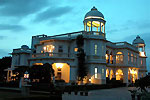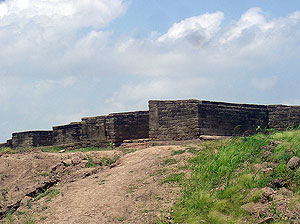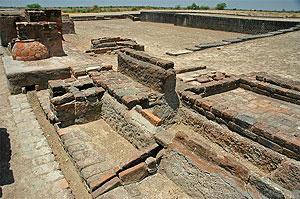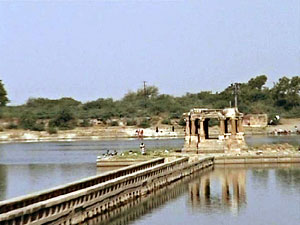|
|
|
|
Gujarat Tours |
|
|
|
|
|
|
|
|
|
|
|
|
|
|
Gujarat Hotels |
|
|
 |
|
|
|
|
|
|
Lothal |
|
|
|
|
|
Lothal is situated
about 85 kms. southwest of Ahmedabad. This important
archaeological site was discovered in 1954. The city
that stood here 4500 years ago is clearly related to
the Indus Valley cities of Mohenjodaro and Harappa,
both in Pakistan. It has the same neat street pattern,
carefully assembled, neat brickwork and scientific
drainage system. Lothal means mound of the dead in
Gujarati. Lothal is located between the Sabarmati
river and the Bhogavo river and is now 10 kms. up from
the Gulf of Khambhat (Cambay). It has some of the most
substantial remains of the Harappan culture in India,
dating from 250 to 1700 BC. Its site and function as a
port have led most authorities to argue that it was
|
 |
|
|
settled by Harappan
trading communities who came by sea from the mouth of the
river but some believe that it may have been settled by
traders moving across the overland route. The site is
surrounded by a mud brick embankment 300 m North to South
and 400 m East to West. Unlike the defensive walls at
Harappa and Mohenjodaro, the wall at Lothal enclosed the
workers area as well as the citadel. The presence of a dry
dock and a warehouse further distinguish it from other major
Harappan sites. Excavations here have revealed a tidal
dockyard (with a complex lock-gate system) at its peak, this
was probably one of the most important ports on the Indian
subcontinent. The Sabarmati river, which no longer runs past
here, connected the dock to the Gulf of Cambay. Seals
discovered at the site suggest that trade may have been
conducted with the civilizations of Mesopotamia, Egypt and
Persia.
Dry Dock
The dry dock runs along the east wall of the city and has
average dimensions of a 214 m by 36 m. A 1 m wide gap in the
north side is believed to have been the entrance by which
boats came into the dock. While a spillway over the south
well allowed excess water to overflow. The city well, which
is wider at this point than elsewhere, may have been a wharf
for unloading. Excavations of the warehouse have revealed
wide evidence of the trade which was clearly the basis for
the Lothal's existence. The building, at the south-west
corner of the wharf, had a 4 m high platform made of cubical
mud brick blocks, the gap between them allowing ventilation.
Over 65 Indus Valley Seals have been discovered which shows
pictures of packing material, bamboo or rope, suggestive of
the importance of trade to the community. There have also
been finds of pottery, semi-precious stones, beads and even
necklaces made of tiny beads of gold. Rice and millet were
clearly in use, and there is some evidence that horses had
been domesticated. |
|
|
|
The city
The excavations show a planned city in a grid pattern,
with underground drainage system, wells, brick houses
with baths and fireplaces. The raised brick platform
to the southeast may have been a kiln where seals and
plaques were baked. Objects found include painted
pottery, ivory, shells, semi-precious stone items,
beads, bangles and terracotta toys. The long
rectangular tank to the east may have been used as a
dock. The discovery of a seal from Bahrain suggests
that there was overseas trade. The cemetery to the
northwest had large funerary vessels indicating pit
burials. The archaeological museum at |
 |
|
|
the site displays fragments of this
well-ordered civilization, such as intricate seals, weights
and measures, games, jewellery and various artifacts
including copper and bronze implements from the site.
|
|
|
|
Dholka
Dholka was built as the residence of the Muslim
Governor of Delhi. The Masjid of Hilal Khan Qazi has a
simple facade with two turets flanking the central
arch. The Tanka Masjid has over 100 Hindu pillars
suggesting that a purely Islamic style had not yet
developed. The other mosque of Alif Khan is unlike
other Gujarati mosques of the period in that its is of
brick. Davies suggests that it is South Persian in
design and execution, the workers migrating as a
result of the coastal shipping trade.
How to reach
Lothal |
 |
|
|
By Rail:
The nearest railway station is Burkhi on the Ahmedabad -
Bhavnagar railway line.
By Road:
Lothal is connected by road with all the major cities of
Gujarat like Ahmedabad, Bhavnagar, Rajkot, Bhuj and Vadodara. |
|